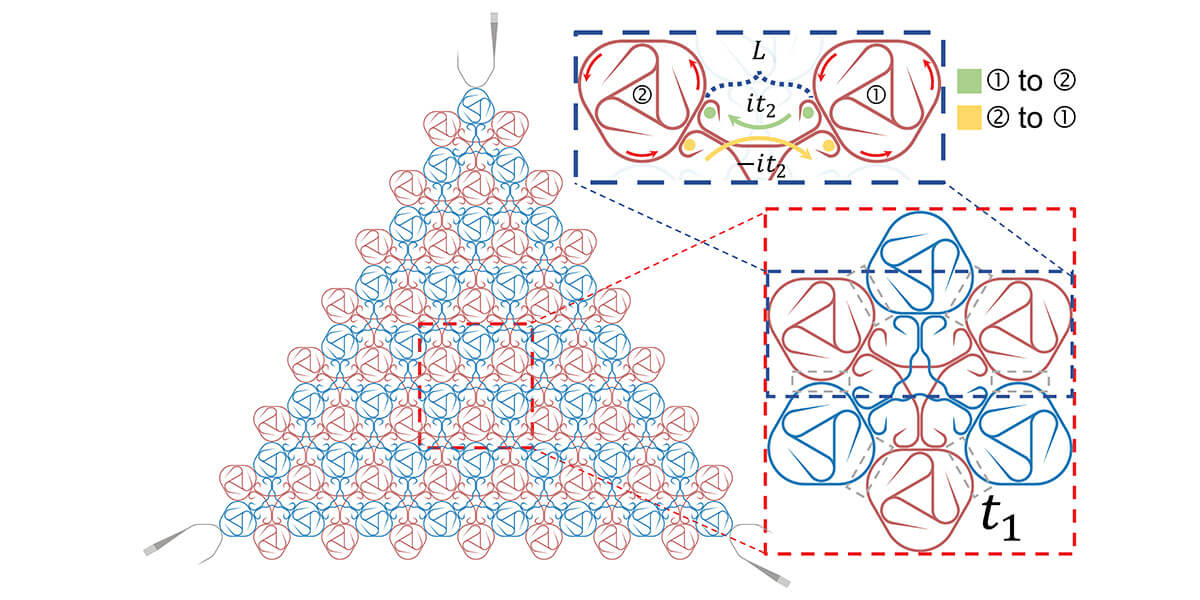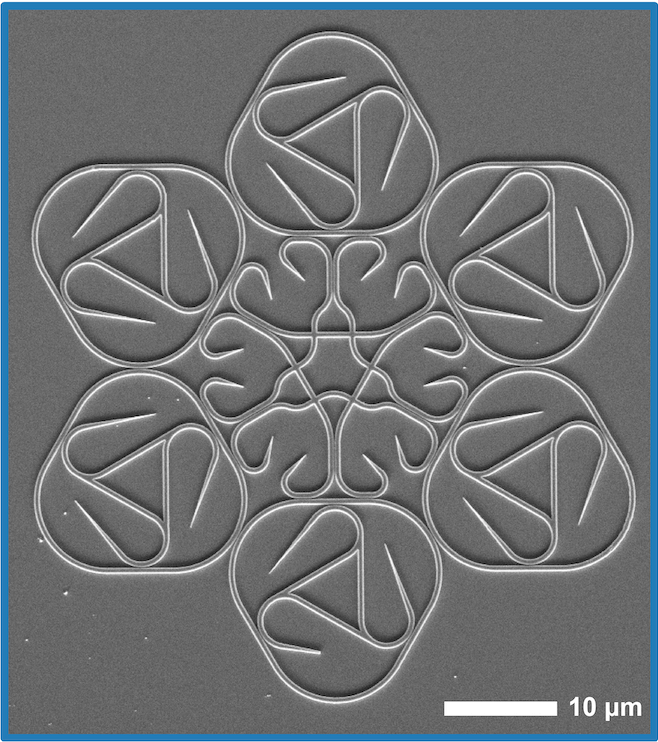
This novel structure designed by Khajavikhan and PhD student Nathan Liu produces uniquely shaped light and is only one quarter of a millimeter squared in size (PHOTO CREDIT: Nathan Liu)
Take a close look at the picture at the top of this story. What you’re looking at may not be a bridge, or a jet engine, or fancy algorithm or a new medical imaging device. It doesn’t have any moving parts and it’s not made from some space-age, next-gen material. It is, however, a groundbreaking design in a field of engineering you benefit from every day and probably know very little about: photonics.
This novel structure was designed by Mercedeh Khajavikhan, a USC Viterbi associate professor of electrical and computer engineering, and her Ph.D. student, Yuzhou (Nathan) Liu, to do one thing: change the shape of light as it is transported.
In a recent paper published in Nature Physics, Khajavikhan, the IBM Early Career Chair, and her team showed how this can be done by using a new theoretical model that could have profound implications on many aspects of our lives. Before we get into the structure itself, a bit about photonics and light.

The structure is made up of many individual “cells” that fit together to make the final shape (PHOTO CREDIT: Nathan Liu)
Light can be generated by lasers for imaging and sensing; run through fiber optic cables for advanced communications; and built into chips to increase computing capabilities to a level earlier generations couldn’t have dreamed of. Each of these advances may have ended with a new device built by a mechanical, astronautical, biomedical, or computer engineer. But they got their start in photonics, where researchers like Khajavikhan engineer the new light structures that make all this possible.
As you probably already know, light particles tend to move as waves. Photonics is the science of harnessing those waves, and it is used by scientists and engineers to do amazing things. From the cutting-edge experiments of quantum communication with entangled photons, to everyday technologies like smartphone screens, LiDAR and fiber internet, photonics has changed our lives more than most people realize. And even though the field has been around for over a century, researchers like Khajavikhan and Liu are still pushing into new frontiers.
One of these frontiers is called topological photonics. It combines traditional photonics with topological physics – a field pioneered in part by Nobel Prize winner and former USC Professor Duncan Haldane. Topological physics — the mathematical study of shapes and their arrangement in space — has been used to explain many interesting properties in electronics and has led to the development of several new materials and devices. Now, by combining topological physics and photonics, researchers can engineer even more creative and never-before-seen light structures.
So, what is so special about this new structure and how did they build it? The team uses topological physics to come up with a design they want to explore. They then run simulations to understand how the elements in the structure should interact with each other. Next, they design the individual cells – the little building blocks that make up the whole structure. Once the cell design is complete, they must decide how they should be arranged together to form the structure. Finally, the design is taken to one of the USC Viterbi School of Engineering’s nano-fabrication clean rooms where the physical product — less than 0.25 square millimeter in size — is built. What we are left with is a totally unique structure that forms light into a novel shape when it flows through it. This new shape, in turn, has new qualities, such as better lasing purity and higher efficiency.
As impressive as that is, Khajavikhan and her team decided to go even further. And this is where that combination of physics and photonics really comes into play. Topological materials can exhibit amazing new transport properties, but they cannot easily be switched between an “on” and “off” state. Think about these light structures like a state-of-the-art race car. They can move faster, turn harder, and do more than their competitors. But if you can’t ever turn the car off once you’ve started the engine, it’s not a very practical piece of machinery.
That’s exactly what the USC team was able to do – control this new light. They introduced a technique from photonic systems called “optical pumping” to give the topological properties of the structure the ability to turn on and off. The ability to control not just the shape of light, but when and how it flows through a system is of utmost importance. After all, the first people to have electricity installed in their homes were undoubtedly excited to light up a room. But imagine if they couldn’t ever turn the lights off!
For Liu and Khajavikhan, the work on this new structure is only just the beginning. “Our findings open up completely new avenues to study topological systems and we plan on engineering more designs that could change the face of a whole host of industries such as holographic screens and high power lasers,” said Khajavikhan.
Published on March 9th, 2021
Last updated on May 16th, 2024







